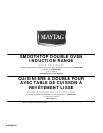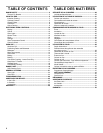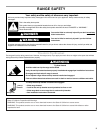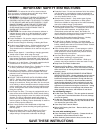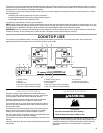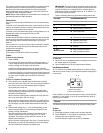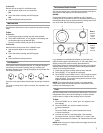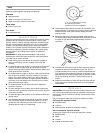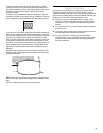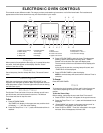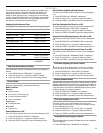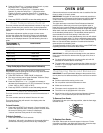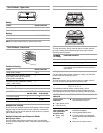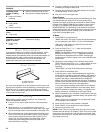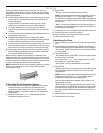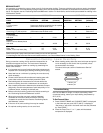
8
Tones
Tones are audible signals, indicating the following:
One tone
■ Valid pad press
■ Slider is moved to “0” power level
■ Slider is moved to “Boost” power level
Three tones
■ End of Timer cycle
Four tones
■ Invalid pad press
Ceramic Glass
Clean the cooktop after each use to help avoid scratches, pitting,
abrasions and to condition the glass surface. Ceramic glass
cooktop cleaner, cooktop cleaning pads and a cooktop scraper
are also recommended for stubborn soils. Do not use abrasive
cleaners, non-approved cleaning pads or harsh chemicals for
cleaning. The Cooktop Care Kit Part Number 31605 contains all
of the items needed to clean and condition your ceramic glass
cooktop. Refer to the “Range Care” section for additional
information.
IMPORTANT: To avoid permanent damage to the cooktop
surface and to make soils easier to remove, clean the cooktop
after each use to remove all soils.
■ Avoid storing jars or cans above the cooktop. Dropping a
heavy or hard object onto the cooktop could crack the
cooktop.
■ To avoid damage to the cooktop, do not leave a hot lid on the
cooktop. As the cooktop cools, air can become trapped
between the lid and the cooktop, and the ceramic glass could
break when the lid is removed.
■ For foods containing sugar in any form, clean up all spills and
soils as soon as possible. Allow the cooktop to cool down
slightly. Then, while wearing oven mitts, remove the spills
while the surface is still warm. If sugary spills are allowed to
cool down, they can adhere to the cooktop and can cause
pitting and permanent marks.
■ To avoid scratches, do not slide cookware or bakeware
across the cooktop.
■ To avoid damage to the cooktop, do not allow objects that
could melt, such as plastic or aluminum foil, to touch any part
of the entire cooktop.
■ To avoid damage to the cooktop, do not use the cooktop as a
cutting board.
■ Use cookware about the same size as the surface cooking
area. Cookware should not extend more than ½" (1.3 cm)
outside the area. Minimum pan size is also noted on the
cooktop with the inner ring, if applicable.
■ Use flat-bottomed cookware for best heat conduction and
energy efficiency. Cookware with rounded, warped, ribbed or
dented bottoms could cause uneven heating and poor
cooking results.
■ Determine flatness by placing the straight edge of a ruler
across the bottom of the cookware. While you rotate the ruler,
no space or light should be visible between it and the
cookware.
■ To determine which pan to use on which induction element,
measure the bottom of the flat area of your pan. Do not
include the sides if they curve up. Use this measurement to
help determine which induction element would best fit your
pan. Manufacturer measurements listed on pans are usually
for the top opening dimension. The flat bottom may be
smaller.
■ Make sure the bottoms of pots and pans are clean and dry
before using them. Residue and water can leave deposits
when heated.
Cookware
IMPORTANT: This range has induction cooktop elements. Pan
size, material and positioning are very important to achieve the
best results. See the “Induction Cooking” section before using
the cooktop.
Only ferromagnetic pans can be used for induction cooking.
Ferromagnetic materials include:
■ Enameled steel
■ Cast iron
■ Stainless steel designed for induction cooking
Non-ferromagnetic materials include:
These types of pans will not work with induction cooking.
■ Stainless steel
■ Glass
■ Ceramic
■ Copper or aluminum pans
A.½" (1.3 cm) Maximum overhang
B.Outer edge of cooktop
C.Minimum pan size, if applicable
A
B
C
1
2
3
4
5
6
7
8
9
1 0
1 1
1 2
1 3
1 4
1 5
1 6
1 7
1 8
1 9
2 0
1
2
3
4
5
6
7



